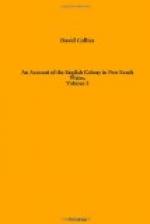To the extreme eastern point of this land, a fine easterly breeze had brought them at daylight of the 6th; when they found that what they had on the preceding evening taken to be islands were three lumps or ridges of the point itself, lessening in bulk as they advanced toward its seaward extremity. The very uncommon figure of this point may perhaps be best conceived by comparing it to a spear with several barbs. It was extremely barren and rocky. Beyond the point, the coast trended more northerly, but fell back into an extensive bay, with a sandy beach in its rear. The western point of this bay was formed by a high, steep, and round bluff, named Circular Head, that might easily be taken for an island, but was a peninsula. The land behind was of moderate height, and rose gradually from the sea. It was clothed in a poor coat of either grass or short brush; among which were seen some dwarf gum trees, that appeared to be in a sickly and dying state, apparently for want of sufficient soil to expand in.
Towards noon, soon after passing Circular Head, the outermost land in sight stretched so far to the northward, that the course to clear it was NNW. It formed like two hummocks, and in steering for it they were compelled to leave a large bight unexamined. The coast at its back was too distant to form any judgment of it, except in the general outline. Its westernmost part seemed broken and intersected, like islands and gaps; but, as the wind blew fresh and directly into it, they passed on.
Nothing new presented itself on the following day, but some small flights of sooty petrels.
On the 8th, being threatened with a gale, they came to anchor under the land, off a small beach on its NE part, where the SW wind could not molest the vessel. Here Mr. Bass landed to examine the country, but found it impenetrable. The tall sturdy brush wood grew so close that their dogs could hardly make their way through it. Large patches appeared to have been burnt many months ago, but the small brush and creeping vines only were destroyed; the closeness of the blackened saplings were still irresistible. A few starved gum trees erected their sickly heads above the brush, and the whole wore an aspect of poverty which the sandy soil confirmed. And yet this place was inhabited by men, as was shown by the old fire places strewed round with shells of the sea ear. The rocks were composed of quartz, probably a species of granite, but much unlike that which formed Furneaux’s Islands.
Leaving this place on the 9th, they steered for the outermost land in sight, which bore to the southward of west, and was distant three or four leagues. After rounding the seaward end of the land under which they had anchored, its shores fell back, and at last discovered to them that it was an island of from fifteen to twenty miles in circuit, and situated between four and five from the main. It was with the greatest astonishment that they recollected the fire places




